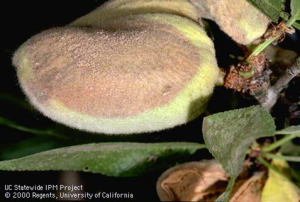Hull rot infections can cost growers a lot of money; money in lost crop this year, money in more sanitation costs this winter, and money in lost spurs and shoots for future crops. There are two disease organisms responsible for hull rot damage. The first is Monilinia (brown rot), which infects the hull just prior to hull split in early to mid-June and doesn’t show the black mold characteristic of the second hull rot causing organism, Rhizopus, which infects the nut after hull split. Monilinia hull rot damage is often hard to diagnose as hull rot. The black mold is missing and the brown rot fungus doesn’t show on dried nuts. One or both organisms can infect hulls in the same orchard. Darkening of the xylem tissue below infected nuts is a consequence of hull rot.
The following are practices that, when combined into an integrated hull management program, deliver the best possible control of this costly problem:
- Manage nitrogen (N) fertilizer inputs to keep summer leaf N levels across the orchard under 2.6% N. Leaf levels of 2.2% N or less = deficient, so 2.6% is more than adequate to maintain orchard health and yield potential. This can be done by carefully matching N inputs to cropload and/or tree growth needs. Spring leaf sampling can help. Don’t apply fertilizer N after May 15 in blocks with a hull rot history. This will not impact nut growth if adequate N applied before this cut off date.
- When weather conditions (rain or dew) or orchard history of Monilinia hull rot exist, consider an early June fungicide application. Rainfall on June 8, 2017, ranging from 0.08” in Arbuckle to 0.60” in Durham, could have produced a Monilinia hull rot infection event. In general, effective fungicide materials include FRAC 3, 11, and 19 fungicides (and mixtures containing those chemistries) which are are effective in reducing, but not eliminating, hull rot strikes. Best pest control results require good coverage, so a properly calibrated sprayer is crucial to efficacy of treatment.
- As hull split approaches, manage irrigation to deliver moderate water stress (-14 to -18 bars readings on a pressure bomb) during hull split. See article in latest newsletter on this practice. This practice can help tighten up hull split window and so help with early harvest for NOW control.
- Where conditions and/or orchard history show a need, apply a fungicide (same material options as for Monilinia infections) at early hull split to reduce Rhizopus infections.
The best hull rot control is delivered by a combination of these treatments/approaches. Don’t forget June Monilinia hull rot treatments if rain appears in the forecast.



Leave a Reply